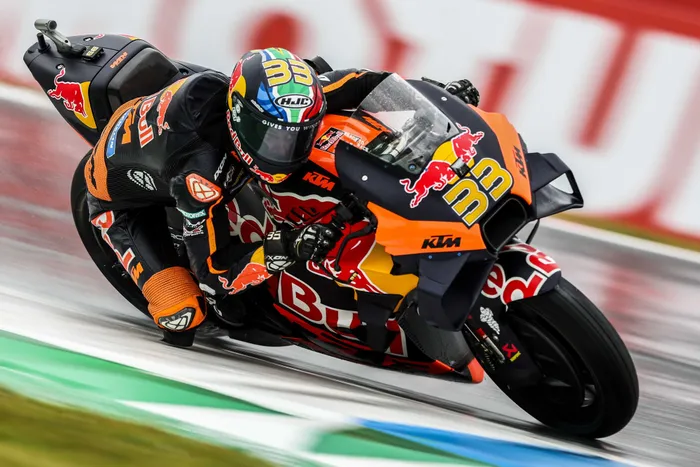KTM slashes half of workforce, MotoGP team to take knock
Brad Binder's team undergoing big changes

South African rider Brad Binder of Red Bull KTM in action during the MotoGP Dutch Grand Prix with bad news for the workforce of the team as KTM announces decision to cut at least 50% of white colour labour force. | EPA
Image: EPA
Bajaj Auto’s shock plan to cut more than half of KTM’s white-collar workforce has sent ripples through the paddock — and the factory’s MotoGP programme looks set to feel the pain.
Rajiv Bajaj said the company will “reduce overheads by more than 50 per cent, including Research and Development, marketing (including racing), operations, and general administration,” as Bajaj moves to take full control of the Austrian firm.
Bajaj did not mince words when assessing what went wrong under KTM’s previous leadership. “The previous management has already reduced headcount from 6,000 to 4,000, which is still considered too high,” he said, adding the imbalance between blue- and white-collar staff was “perplexing.”
He went further, invoking corporate missteps and “corporate greed” that led to overproduction and strategic diversions — e-bikes singled out as an example — which, he argued, pushed KTM toward insolvency.
Those cuts — aimed at restoring financial stability and streamlining the business — include areas that directly underpin MotoGP performance: R&D, engineering, and marketing support.
Motorsport insiders warn that slashing those departments will almost inevitably reduce upgrade velocity for the RC16, limit testing time and constrain the pipeline of new components that keep a factory bike competitive between seasons.
With rivals like Ducati and Aprilia continuing an aggressive development push, any prolonged slowdown at KTM risks a widening performance gap.
KTM’s RC16 has already shown the consequences of constrained development this year. Factory riders and team engineers have struggled with persistent tyre-related problems and chassis setup that produce severe rear-end chatter and a lack of front grip.
Brad Binder has been candid: “We’ve had a lot of chatter and are missing some front grip, so they’ve been playing with the stiffnesses and balances to try and make this problem a little bit less.”
He added that unless KTM can “get rid of our chatter problem, we would be in a very, very different situation right now.”
The chatter has produced dramatic race moments and brutal weekends. Binder described the Qatar’s sprint as “probably the worst race of my life,” where repeated rear chatter forced him off the track multiple times.
Those kinds of mechanical and balance shortcomings are precisely the sort of problems solved by sustained R&D and testing — exactly the parts of KTM now earmarked for cuts.
Bajaj frames the restructuring as necessary: restore order, cut waste, and return KTM to profitability. But for MotoGP the timing could not be worse.
A program that already arrived at key races fighting tyre wear, vibration and setup windows will now likely see slower upgrade cycles and fewer resources to chase quick fixes.
In short, the RC16 may have to fight this season — and next — with one hand tied behind its back.
If Bajaj’s gamble restores KTM’s health, the long-term outcome could be positive. In the short term, however, the factory’s riders and engineers must brace for a leaner era in which development is earned more slowly — and where on-track suffering could be the price of saving an ailing motorcycle brand.